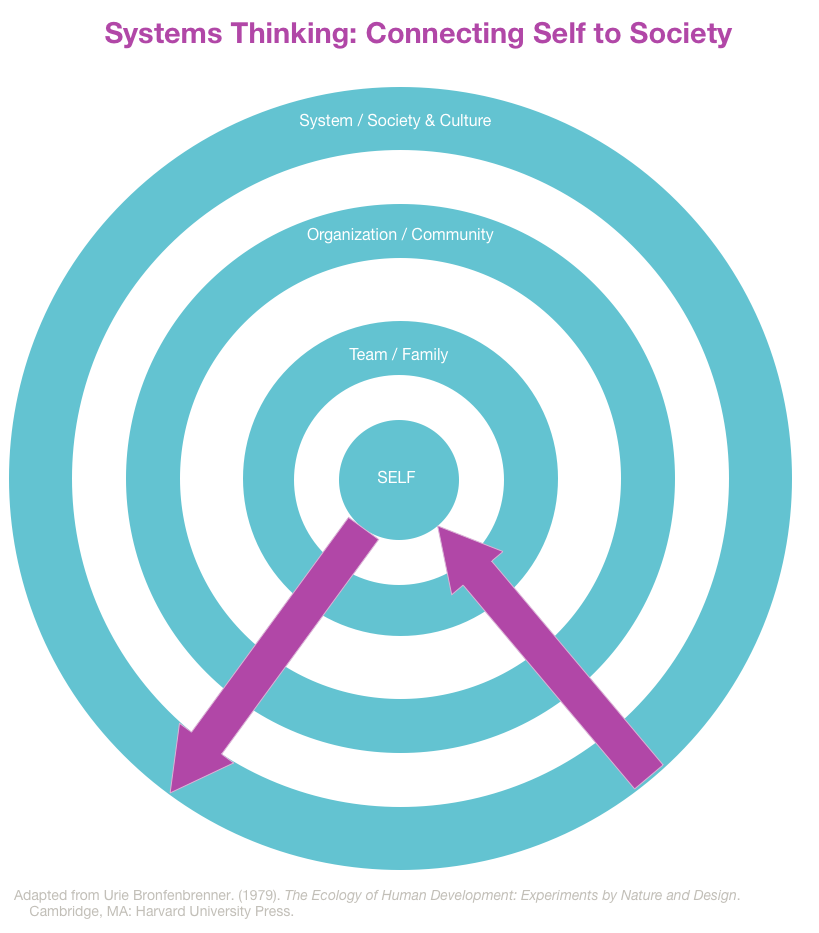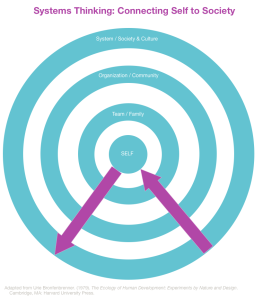
About Systems Thinking
A particularly interesting theory has emerged over time, which takes a deeper look into the interactivity of different levels of systems, whether in nature or in society. Using a systems-thinking approach (von Bertalanffy, 2003 revised), an individual or a group considers the whole system and how different parts of that system interact with, or are affected by, other parts. Instead of looking at an isolated situation (or problem), and then trying to fix or change that singular challenge in isolation, a systems-thinker looks for connections to other parts of the system.
In an attempt to understand why the situation is as it is, a systems-thinker attempts to uncover what is influencing this situation and what impact a change on the situation (or an outside influencer) could have to move towards the desired outcome
Here’s a hypothetical example: An individual in the marketing department begins using a new tool to streamline her communications with customers. Because she is able to react–let’s say 10%–faster to requests, there is an effect on other parts of the system. The 50-person manufacturing department now receives information about customer needs faster, which in turn allows them to improve quality by 25%. A small change by one person had a larger effect on the rest of the organization, and improved customers’ experiences. Had the organization looked to improve quality by focusing only on the testing division, perhaps a more complex “fix” to the situation would have resulted, and the costs could have been higher than the benefits.
Practicing Systems Thinking in Human Systems

First, take a look at the image to the left. Notice how there are different levels with “self” at the center, and increasingly broader levels of system outside each concentric circle. At the core of engaging in systems thinking, the individual (in this case, you) should review how their personal actions influence a particular situation, and how other levels of the system are affecting them in relation to the situation. Then, the analysis moves to each concentric circle outwards. Peter Senge’s top-seller, The Fifth Discipline (Senge, 2010 revised), explains this process in more detail.
Questions for thought include:
- How do I influence my team (or family) in this situation?
- How do they influence me?
- How does my team/family influence our community?
- How does our community influence our society?
After understanding these relationships of influence, the individual (you!) can begin to look for opportunities to take advantage of your influence to make change to improve your life as well as the lives of others. It might sound daunting to make drastic changes in society, such as how to end poverty. It likely is not in your sphere of influence or authority to be able to make sweeping socio-economic changes (or so you think). This is where systems-thinking is so critical. You have influence on someone—whether it is a friend, co-worker, or your Facebook readers. Talking about the situation, sharing ideas, and taking action towards your end goal can begin to influence others to join in the change and transform the community. As momentum grows, pressure is put on society to make these changes.
Recall the civil rights movements we have witnessed across the globe and in different eras. There has usually been one person who decided to make a difference (think Martin Luther King, Jr. or Mother Theresa). They began influencing their friends and family, and then reached out to their communities, and eventually began to influence society to change laws and behavior (equality for people of color in the USA for Dr. King and care of the poor–who are treated as outcasts without rights–for Mother Theresa, respectively).
Putting this into action, pull out a piece of paper and place your name in the middle along with a change you would like to make (no matter how big or small). Next, write down what strengths or skills you have that you can use to make this change. If there is anything about your self (behaviors/actions, beliefs, etc.) that you want to change, jot those down, too, and label them “aspirations.” Draw a circle around this—it is your “self” sphere of influence.
Now, draw another circle around this one (leave some space to write down more ideas!) and label it “team” if you are doing this for work, or “family & friends” if it is a personal situation. Now, write down on the left side how your team or family are impacting you in this situation, with an arrow pointing towards “self”. On the other side, write down the ways you can begin to impact your team or family to help you make this change, with an arrow coming out of “self” towards “family & friends”.
Continue this exercise with increasingly larger parts of your system. Next, consider what steps you will take today, tomorrow, next week, and beyond. Consider some quick-win activities to help you see some accomplishment early on and feel confidence and accomplishment on your journey. Avoid goals that you know are too lofty for yourself, which you are certain you would not achieve – keep them aspirational enough to help you change the situation, but realistic enough that you will feel motivated to continue through the process. As you gain more practice and realize what you are capable of doing, adding increasingly more challenging goals will help you do even more and more.
Potential Benefits
Have you noticed crowds of people going in the same direction, but no one can explain exactly where they are going or why? Have you seen societies or cultures act together, but most people cannot explain why they are behaving that way, except to say “because everyone else is doing it!”? Following a herd is easy to do, and it is easy to believe that your actions have no consequences, because the whole group or crowd or society is acting that way… so it must be acceptable. However, your actions do have consequences and you are responsible for your own behavior – even if only to answer to your own conscience. Using systems thinking empowers you to take only those actions you want to take, not the ones others force or compel you to do.
In addition, by assessing situations from a systems perspective, you are likely to understand how you impact systems, and how systems impact you. This way, you can navigate better the situation, and either influence the system or ask others for what you want or need in a way that is more likely to result in a positive outcome. Ben Stein has said, “The first step to getting the things you want out of life is this: Decide what you want.” If you do not yet know exactly what you want in the context of the system, expect an uphill climb to getting what you want. Knowing the consequences or reactions to changes in the system that bring you what you want out of life will make it easier to carve a path that navigates you to your goal.
Good luck on your journey to understanding your self and the systems in which you operate. Post your goals, or the journey you have taken.
References
Senge, P. (2010 revised). The fifth discipline: The art and practice of the learning organization. Crown Publishing Group.
von Bertalanffy, L. (2003 revised). General System theory: Foundations, Development, Applications. Penguin University Books.
